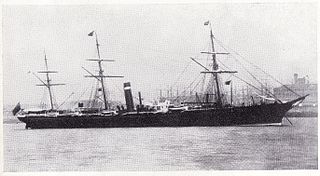Holland America Line N.V. (HAL) is an American-owned cruise line, a subsidiary of Carnival Corporation & plc headquartered in Seattle, Washington, United States.

RMS Oceanic was a transatlantic ocean liner built for the White Star Line. She sailed on her maiden voyage on 6 September 1899 and was the largest ship in the world until 1901. At the outbreak of World War I she was converted into an armed merchant cruiser. On 8 August 1914 she was commissioned into Royal Navy service.

Ellerman Lines was a UK cargo and passenger shipping company that operated from the late nineteenth century and into the twentieth century. It was founded in the late 19th century, and continued to expand by acquiring smaller shipping lines until it became one of the largest shipping firms in the World. Setbacks occurred through heavy losses to its merchant fleet in the First and Second World Wars but were overcome in each case.

RMS Britannia was an ocean liner of the British and North American Royal Mail Steam Packet Company, later known as Cunard Steamship Company. She was launched on Wednesday 5 February 1840, at the yard of Robert Duncan & Company in Greenock, Scotland. The ship and her Britannia-class sisters, Acadia, Caledonia, and Columbia, were the first ocean liners built by the company.

A infantry landing ship was one of a number of types of British Commonwealth vessels used to transport landing craft and troops engaged in amphibious warfare during the Second World War. LSIs were operated by the Royal Navy, British Merchant Navy, Royal Canadian Navy, Royal Indian Navy, and Royal Australian Navy. They transported British Commonwealth and other Allied troops in sea assaults and invasions throughout the war.

Storstad was a steam cargo ship built in 1910 by Armstrong, Whitworth & Co Ltd of Newcastle for A. F. Klaveness & Co of Sandefjord, Norway. The ship was primarily employed as an ore and coal carrier doing tramp trade during her career. In May 1914 she accidentally rammed and sank the ocean liner RMS Empress of Ireland, killing over 1,000 people.

The Royal Mail Steam Packet Company was a British shipping company founded in London in 1839 by a Scot, James MacQueen. The line's motto was Per Mare Ubique. After a troubled start, it became the largest shipping group in the world in 1927 when it took over the White Star Line. The company was liquidated and its assets taken over by the newly formed Royal Mail Lines in 1932 after financial trouble and scandal; over the years RML declined to no more than the name of a service run by former rival Hamburg Süd.

Manchester Liners was a cargo and passenger shipping company founded in 1898, based in Manchester, England. The line pioneered the regular passage of ocean-going ships along the Manchester Ship Canal. Its main sphere of operation was the transatlantic shipping trade, but the company also operated services to the Mediterranean. All of the line's ships were registered in the Port of Manchester, and many were lost to enemy action during the First and Second World Wars.

City of Paris was a British passenger liner operated by the Inman Line that established that a ship driven by a screw could match the speed of the paddlers on the Atlantic crossing. Built by Tod and Macgregor, she served the Inman Line until 1884 when she was converted to a cargo ship.

Inkosi was a 6,618 GRT refrigerated cargo liner which was built by Swan, Hunter & Wigham Richardson Ltd, Newcastle upon Tyne for the Ministry of War Transport (MoWT). She was hired by the Royal Navy in 1940 for use as an ocean boarding vessel, but was sunk in an air raid before she could be used for this purpose. The ship was salvaged, converted to a cargo ship and passed to the Ministry of War Transport (MoWT), who renamed her Empire Chivalry. In 1946 she was sold and renamed Planter. She served until 1958, when she was scrapped.

Wahehe was a 4,690 GRT cargo ship which was built in 1922 as Wadigo by Reiherstieg Schiffswerfte und Maschinenfabrik, Hamburg for Woermann Linie AG. She was converted to a refrigerated cargo liner in about 1934.

RMS Franconia was an ocean liner operated by the Cunard Line from 1922 to 1956. The liner was second of three liners named Franconia which served the Cunard Line, the others being Franconia (1910) built in 1910 and the third Franconia in 1963.

SS Traffic was a baggage tender of the White Star Line, built in 1872 by Philip Speakman in Runcorn and made of English Oak.

The SS Georgic was a steam ship built by Harland and Wolff for the White Star Line to replace the SS Naronic which was lost at sea. Georgic was a cargo ship designed principally to carry livestock, at the time of entering service in 1895 she was the largest cargo ship in the world with a deadweight tonnage of 12,000 tons.

Glen Line was a UK shipping line that was founded in Glasgow in 1867. Its head office was later moved first to London and then to Liverpool.

Estrella de Chile was an iron three-masted barque of the Glen Line built to ply the route between Glasgow, Liverpool, and Chile via Cape Horn. The ship was wrecked in the Solway Firth on 25 November 1888 after getting into difficulties when the master misjudged the ship's position. The first mate drowned, but the rest of the crew were rescued by a lifeboat.

The Glenavon was a British iron cargo ship of the Glen Line that was wrecked off the coast of China in 1898. Four people, but not the master, lost their lives in the wreck. The master had his licence suspended for one year.

The Delphic was a British freighter operated by the White Star Line, the company's second ship to bear this name. She was built by the Harland & Wolff shipyards in 1916 to serve the war effort under the name of War Icarus, belonging to the series of "Type G" cargo ships. Launched in September 1918 and commissioned in the following October, she was the only ship in the series to be completed before the end of the First World War. During this time, she was operated by a Liverpool company.

SS Afric was a steamship built for White Star Line by Harland and Wolff shipyards. She was of the Jubilee class, had a reported gross register tonnage of 11,948, and had a port of registry of Liverpool, England. Afric was launched on November 16, 1898, and was involved in shipping between Liverpool and Australia.


















